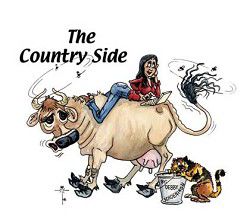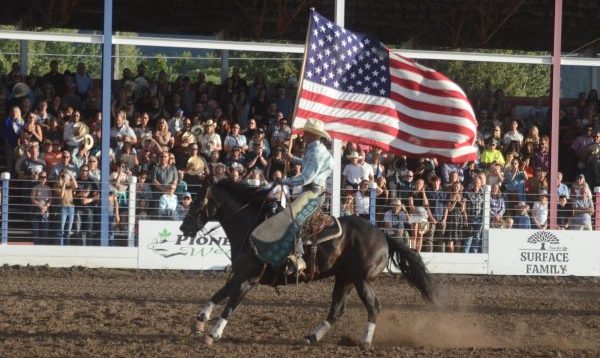The Country Side: Baling Twine 101
Published 5:00 pm Wednesday, April 16, 2008

- The Country Side: Baling Twine 101
When I married into the ranching industry, one of my first lessons was in baling twine protocol. You might think that baling twine is just something to hold hay together in a bale, and it is, but baling twine is also the cornerstone of all ranching activities.
Without it, how would ranchers hold fences together? What else would they tie their stock dogs up with when they won’t stop chasing the neighbor’s cattle? They wouldn’t be able to keep the bumper on that old Ford truck without baling twine. And some wouldn’t be able to shut a gate, close a door or keep a tractor hood secured in the down position without baling twine.
Trending
As you can see, it has a multitude of uses, so it is essential to learn the proper handling of baling twine, and that knowledge has been handed down from generation to generation since the days of yore.
History books have revealed that some form of baling twine was used as early as the 1800s. One notable passage was from the book, “Feeding the Cows,” written in 1829 by Maken Nomoney, where a farmer reprimanded his son by saying “You pulleth those trousers up with thine bailing twine boy.”
In fact, now that I think about it, ranchers might be able to make some extra cash by selling baling twine to the plumbing industry for that same use.
The first thing that I learned about baling twine was that it has to be organized – you can’t just wad the stuff up and throw it in a big heap – it has to be neatly tied and then thrown in a big heap. You may find yourself wondering why this makes a difference since it all ends up in a pile anyway, but trust me; there is nothing that will get you in more trouble with a rancher than messing with his twine system.
First of all, you have to get the twine off of the bale and there are several things to consider – which side of the bale to cut, where on the twine to make the cut and what implement to cut it with. For this discussion we will consider small two string bales. Trying these techniques with large three and six string bales could cause even more hernias, ruptured discs and greater malaise than you get with the smaller bales.
Most ranchers use pocketknives or a used sickle blade from a swather, which has been transformed into a cutting tool. However, it is seldom that ranch wives are allowed to use these manly devices so a kitchen steak knife will suffice. (Helpful Hint: Ranchers will usually allow you to use their sharp shovel to cut the twine, but only if you promise to dig a couple of postholes with it when you are done.)
Trending
Once you have selected a cutting tool, the bales must be rotated so that the knots tied by the baling machine are on top of the bale. Now for the incision, the twine must be cut exactly 1/2 inch in front of the knot.
Cutting too close to the knot or too far from the knot could cause the demise of the ranching industry as we know it. (Helpful Hint: I got this one from Martha Stewart – Tape a small laminated paper ruler to the side of your steak knife handle – It’s a good thing!)
While hand feeding cattle from the back of a hay wagon, you must learn to juggle several cut strands of twine at once. This is because you are not allowed to put a strand down at anytime during the feeding process. I’m not sure why this is, but I found that doing so causes a rancher to swear, flail his arms and dart around the hay wagon like a chicken with a fox in the henhouse.
On a similar note, you can’t tie a few strands together or tie even half of the strands together, you must keep them neatly organized until you are completely finished, whether you have 10 bales with 20 strings or 40 bales with 80 strings, it makes no difference. (Helpful Hint: If you get more strands in your hands than you can manage, try putting some in your mouth, between your knees and under your arm pits.)
However, if at any time you lose a strand of baling twine and it falls off of the hay wagon, you must be prepared to lose life and limb to save that twine. Even though they already have a pile the size of Mount Everest in the barn yard, jumping in front of charging bulls to rescue a strand, walking into the middle of a herd of mad cows or even getting into a tug-o-war with a cow that has half swallowed a strand is nothing compared to the ire demonstrated by a rancher when you loose one of his precious stands of twine. (Helpful Hint: Don’t lose any twine.)
Once you have finished feeding the cattle, the group of strands are then folded in half, with ends perfectly even (no compromises allowed here) and tied. (Helpful hint: When there are no ranchers looking, you can slip into the barn and stretch your twines out on the floor to make sure both ends are even. To be even more precise you can tack a yardstick down on the floor to measure each strand. Most ranchers won’t even notice that you put it there because men are always measuring stuff anyway.)
Tying the twines involves collecting the folded ends into one hand giving them one twist, (again I’m not sure why, but you don’t want to suffer the consequences of not performing this step) wrapping the loop around the strands forming a hole and pulling the loop through the hole and drawing both ends snug.
They are then gingerly and reverently carried by the looped end to the pile and flung on top of the decaying, tangled heap of orange and blue twine to be utilized another day.









